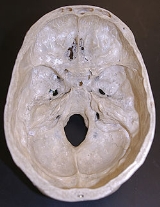
Human skull
Overview
The human skull is a bony structure, skeleton
, that is in the human head
and which supports the structures of the face and forms a cavity for the brain.
In humans, the adult skull is normally made up of 22 bones. Except for the mandible, all of the bones of the skull are joined together by sutures, synarthrodial (immovable) joints formed by bony ossification
, with Sharpey's fibres
permitting some flexibility.
Eight bones form the neurocranium (brain case), a protective vault of bone surrounding the brain
and brain stem
.
Human skeleton
The human skeleton consists of both fused and individual bones supported and supplemented by ligaments, tendons, muscles and cartilage. It serves as a scaffold which supports organs, anchors muscles, and protects organs such as the brain, lungs and heart....
, that is in the human head
Human head
In human anatomy, the head is the upper portion of the human body. It supports the face and is maintained by the skull, which itself encloses the brain.-Cultural importance:...
and which supports the structures of the face and forms a cavity for the brain.
In humans, the adult skull is normally made up of 22 bones. Except for the mandible, all of the bones of the skull are joined together by sutures, synarthrodial (immovable) joints formed by bony ossification
Ossification
Ossification is the process of laying down new bone material by cells called osteoblasts. It is synonymous with bone tissue formation...
, with Sharpey's fibres
Sharpey's fibres
Sharpey's fibres are a matrix of connective tissue consisting of bundles of strong collagenous fibres connecting periosteum to bone...
permitting some flexibility.
Eight bones form the neurocranium (brain case), a protective vault of bone surrounding the brain
Human brain
The human brain has the same general structure as the brains of other mammals, but is over three times larger than the brain of a typical mammal with an equivalent body size. Estimates for the number of neurons in the human brain range from 80 to 120 billion...
and brain stem
Brain stem
In vertebrate anatomy the brainstem is the posterior part of the brain, adjoining and structurally continuous with the spinal cord. The brain stem provides the main motor and sensory innervation to the face and neck via the cranial nerves...
.

